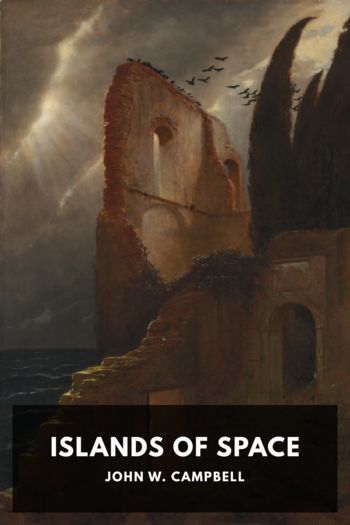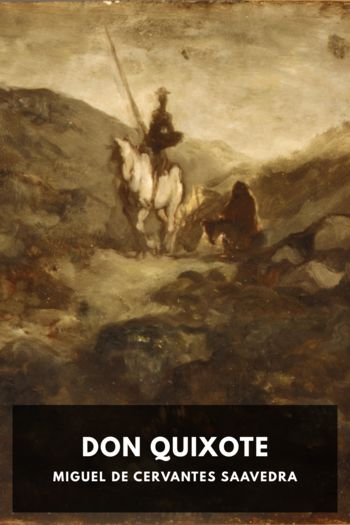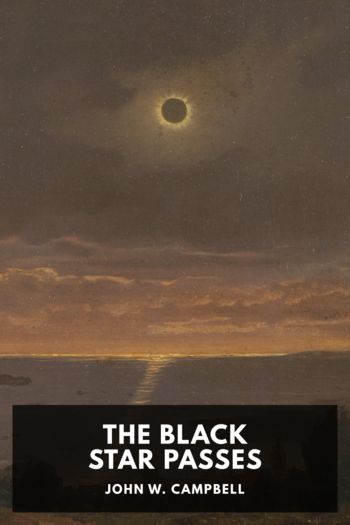Islands of Space, John W. Campbell [self help books to read TXT] 📗

- Author: John W. Campbell
Book online «Islands of Space, John W. Campbell [self help books to read TXT] 📗». Author John W. Campbell
“Hey! Your calculations were off!” called Arcot. “We’re getting out of here!”
Suddenly the air snapped and they were traveling at low speed under the drive of the space-strain apparatus. The entire space about them was lit with a dim violet glow. In ten minutes, the glow was gone and Arcot cut the drive.
They were out in ordinary dark space, with its star-studded blackness.
“What was the matter with my calculations?” Morey wanted to know.
“Oh, nothing much,” Arcot said casually. “You were only about thirty thousand light years off. We landed right in the middle of the central gas cloud, and we were plowing through it at a relative velocity of around sixteen thousand miles per second! No wonder we got hot!
“We’re lucky we didn’t come near any stars in the process; if we had, we could have had to recharge the coil.”
“It’s a wonder we didn’t burn up at that velocity,” said Fuller.
“The gas wasn’t dense enough,” Arcot explained. “That gas is a better vacuum than the best pump could give you on Earth; there are fewer molecules per cubic inch than there are in a radio tube.
“But now that we’re out of that, let’s see if we can find a planet. No need to take photographs going in; if we want to find the star again, we can take photos as we leave. If we don’t want to find it, we would just waste film.
“I’ll leave it to Morey to find the star we want.”
Morey set to work at once with the telescope; trying to find the nearest star of spectral type G-0, as had been agreed upon. He also wanted to find one of the same magnitude, or brilliance. At last, after investigating several such suns, he discovered one which seemed to fulfill all his wishes. The ship was turned, and they started toward the adventure they had really hoped to find.
As they rushed through space, the distorted stars shining vividly before them, they saw the one which was their goal. A bright, slowly changing violet point on the cross-hairs of the aiming telescope.
“How far is it?” asked Arcot.
“About thirty light centuries,” replied Morey, watching the star eagerly.
They drove on in silence. Then, suddenly, Morey cried out: “Look! It’s gone!”
“What happened?” asked Arcot in surprise.
Morey rubbed his chin in thought. “The star suddenly flared brightly for an instant, then disappeared. Evidently, it was a G-0 giant which had burned up most of the hydrogen that stars normally use for fuel. When that happens, a star begins to collapse, increasing in brilliance due to the heat generated by the gas falling toward the center of the star.
“Then other nuclear reactions begin to take place, and, due to the increased transparency of the star, a supernova is produced. The star blows away most of its gaseous envelope, leaving only the superdense core. In other words, it leaves a white dwarf.” He paused and looked at Arcot. “I wonder if that star did have any planets?”
They all knew what he meant. What was the probable fate of beings whose sun had suddenly collapsed to a tiny, relatively cold point in the sky?
Suddenly, there loomed before them the dim bulk of the star, a disc already, and Arcot snapped the ship over to the molecular motion drive at once. He knew they must be close. Before them was the angry disc of the flaming white star.
Arcot swung the ship a bit to one side, running in close to the flaming star. It was not exceedingly hot, despite the high temperature and intense radiation, for the radiating surface was too small.
They swung about the star in a parabolic orbit, for, at their velocity, the sun could not hold them in a planetary orbit.
“Our velocity, relative to this star, is pretty high,” Arcot announced. “I’m swinging in close so that I can use the star’s attraction as a brake. At this distance, it will be about six gravities, and we can add to that a molecular drive braking of four gravities.
“Suppose you look around and see if there are any planets. We can break free and head for another star if there aren’t.”
Even at ten gravities of deceleration, it took several hours to reduce their speed to a point which would make it possible to head for any planet of the tiny sun.
Morey went to the observatory and swept the sky with the telectroscope.
It was difficult to find planets because the reflected light from the weak star was so dim, but he finally found one. He took angular readings on it and on the central sun. A little later, he took more readings. Because of the changing velocity of the ship, the readings were not too accurate, but his calculations showed it to be several hundred million miles out.
They were decelerating rapidly, and soon their momentum had been reduced to less than four miles a second. When they reached the planet, Arcot threw the ship into an orbit around it and began to spiral down.
Through the clear lux windows of the control room, the men looked down upon a bleak, frozen world.
IXBelow the ship lay the unfamiliar panorama of an unknown world that circled, frozen, around a dim, unknown sun, far out in space. Cold and bleak, the low, rolling hills below were black, bare rock, coated in spots with a white sheen of what appeared to be snow, though each of the men realized it must be frozen air. Here and there ran strange rivers of deep blue which poured into great lakes and seas of blue liquid. There were mighty mountains of deep blue crystal looming high, and in the hollows and cracks of these crystal mountains lay silent, motionless seas of deep





Comments (0)